Best stocks to buy in 2025: What to pick as traders hope for another boom year
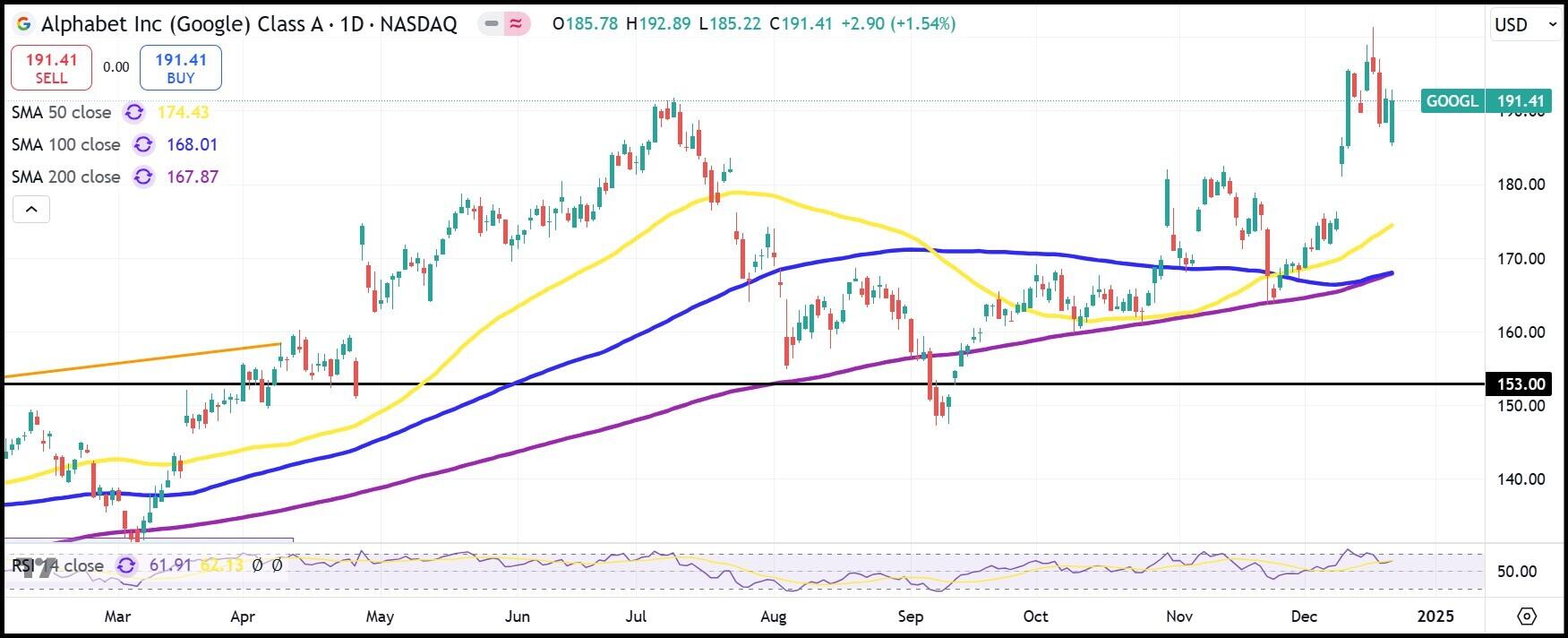
- US stocks had a stellar performance in 2024 for the second year in a row.
- Uncertainty looks set to increase in 2025 as analysts see moderating returns.
- Alphabet, BYD, CVS, Merck and RingCentral are top picks for 2025.
With just a handful of days left to trade equities in 2024, traders are now looking to 2025 and beyond for guidance on the road ahead. The four sessions surrounding Christmas on Wednesday, December 25, will feature continued trading, though Christmas Eve will see a shortened trading session. Then the market reopens on Monday and Tuesday next week – December 30 and 31 – before closing again for New Year’s Day.
Goldman Sachs has put forth the most prominent outlook for 2025, positing that the S&P 500 will close at 6,500 at the end of the year. That estimate implies that the index will rise about 9.6% above the current level.
Still, the index plunged last week in light of the Federal Reserve’s (Fed) newest dot plot predicting just two 25 bps interest rate cuts next year, so the index could end lower than its current perch by the end of 2024. After all, the S&P 500 broke below its 50-day Simple Moving Average (SMA) on Wednesday, December 18, the first time that has happened in over three months.
Stocks in 2024: Second consecutive standout year
Before we look ahead, we should reflect on the achievements and failures of this year before projecting the market’s trajectory.
The S&P 500 ended 2023 at 4,769 after moving out of a rut in October of that year. January 2024 then began the impressive run-up that concluded with the “Trump bump” that followed his election win in November.
The S&P 500 has gained a thunderous 24% thus far in 2024. Equities were on a tear all year as traders thundered back in from the bond market with the expectation that the Fed was imminently prepared to cut interest rates as inflation got under control.
Wall Street originally expected those rate cuts to arrive in the spring, but they had to wait until September for the central bank to reach for its scissors and clip off 50 bps. Two more 25 bps cuts in November and December followed for a full-year deduction of 100 bps. The fed funds rate will end 2024 with a topline rate of 4.5%, but the market grew despondent when the final dot plot guided for just 50 bps worth of cuts in 2025. It seems that the Fed is still unhappy that inflation has grown stubborn near the 3% annualized mark and wants to see further movement toward its 2% target.
Additionally, while the market has done exceedingly well this year and few stock investors are complaining, President-elect Donald Trump’s policy goals of mass deportations and hefty tariffs have begun to be felt in the market. Both policies are inflationary, and investors worry that Trump’s success in either of those arenas could be burdensome to the wider market.
The top large-cap stocks in 2024 involved many companies engaged in the artificial intelligence (AI) arms race. These include Palantir (PLTR), which rose 369% YTD, Vistra (VST) at 263%, and of course Nvidia (NVDA) at 172% YTD. AI is absolutely expected to continue surging in 2025, but the main stocks in this category now look oversubscribed, to say the least.
The outlook for 2025: Toward third year of hefty gains or correction?
The stock market in 2025 will have to deal with general anxiety, at least at the beginning of the year. This is because it comes after two straight years of 24% gains, an unusually good stretch. To get similar back-to-back performances that were good or better, you would have to travel back to the heady days of the DotCom era in 1997 and 1998.
Many prominent observers think the market has gotten ahead of itself and may face a period of consolidation. Hedge fund legend David Einhorn was already characterizing the market as “the most expensive market of all time” in November. Following the bullish frenzy from Trump’s election, Einhorn took to MSNBC to bemoan the pricey market. He noted that the Shiller cyclically-adjusted price-to-earnings ratio (or CAPE) was then at 38, a historically high level.
Bank of America Securities also noted without much fanfare that the market’s current high valuation projects returns as low as 2% a year over the next decade, although that is without including dividends.
In relation to Trump’s penchant for tariffs and tax cuts, high valuations coupled with renewed inflation readings could lead to an unattractive mix over the longer run. He has already aimed tariffs against China, Canada and Mexico, three of the country’s largest trading partners. Einhorn himself doesn’t expect a major pullback, but he does expect the market to trade sideways for the most part.
Trump’s hands-off approach to antitrust issues, however, should make it easier on the mergers & acquisition space. M&A has a pattern of making traders more bullish, and the Biden administration’s strict adherence to antitrust law means there are plenty of pent-up intentions waiting to be unleashed.
And in the short run at least, Trump’s veiled promise about another round of tax cuts should excite stock investors in search of a narrative. Higher net incomes among the wealthy could inflate stock prices, so any reduction in the tax payments of high-net-worth individuals should have a bullish effect on Wall Street.
A few other trends that should be watched in 2025 are quantum computing, the return of Chinese stocks, and beaten-down value stocks returning to form.
Top 5 stocks for 2025: Alphabet, BYD, CVS, Merck, RingCentral
Alphabet: Willow chip could add to tailwinds
Alphabet (GOOGL) has suddenly returned to the limelight late in 2024. Despite posting impressive gains quarter after quarter, Alphabet has become something of a bore over the past few years.
CEO Sundar Pichai is viewed as a bore compared with other visionaries leading the top Silicon Valley tech firms. Ever since Google seemed to drop the ball with the rollout of its AI chatbot Bard in early 2023, the market ignored the leader in search.
But due to a late-year rally, GOOGL stock has gained 37% YTD, and it seems likely that this success will continue.
That’s because the latest interest in Alphabet stems from its sudden unveiling of the Willow chip, what is being called nothing less than a technological breakthrough for quantum computing. The entire quantum computing sector has seen all of its share prices simultaneously soar following Willow’s release.
The quantum computing chip is said to be able to solve complex problems in five minutes that were previously predicted to take longer than the entire length of the universe. Willow now opens up entirely new vistas for technology, and this means that just like Nvidia’s Hopper chips, billions in venture capital may soon start pouring through startups and directly into the coffers of Alphabet.
BYD: Chinese EV maker set to benefit from higher sales
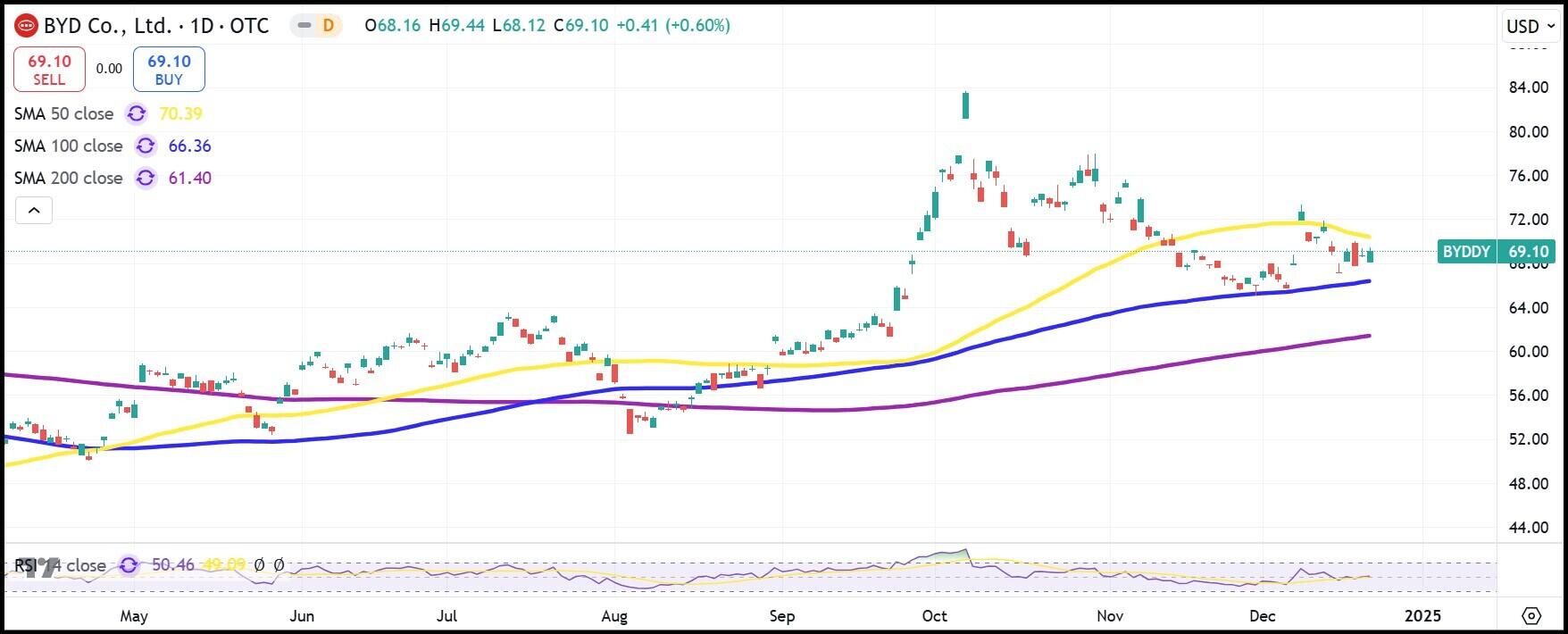
BYD (BYDDY) is the leading Chinese electric vehicle (EV) and produces the most EVs in the world when the data includes hybrids. BYD is who Elon Musk is talking about when he says he’s only worried about competition from China.
Electric vehicle sales are rising 15% to 25% per year globally, and there is no reason that 2025 should be any different. The global light vehicle market is stagnant with sales rising just 1% this past year. Virtually all of the gains in the industry are now coming from EVs, even though the sector makes up just about 17% of total sales currently.
EVs and hybrids are much more popular in China as well, and this makes BYD the best stock to buy in this domain. When Apple (AAPL) tried to quietly enter the EV sector, it chose BYD as its primary engineering partner, though that project was scrapped by Apple early this year.
Like Tesla (TSLA), BYD develops its own Blade LFP batteries that have a reputation for better range than other competitors. BYD’s Chinese market share has climbed from 12% in 2023 to 17% in 2024, and many cite its superior technology and engineering as the main reason.
Sales have been revving higher in 2024 as BYD takes market share from Tesla, Ford (F) and General Motors (GM). Even the recent merger plans announced between Honda and Nissan are said to be based on competing with the superior tech of Chinese automotive firms like BYD.
With 90% of its sales coming from the domestic market, BYD should have a large growth spurt as it looks to export markets. It hired more than 200,000 workers during the autumn season alone, and production has been expanding greatly.
Last of all, the Chinese government looks to have finally turned a leaf and is opening the spigots for fiscal stimulus to revive the economy. This means directly subsidizing workers and providing more capital to state banks. All that money has to go somewhere, and there’s a good chance it goes to the leading automotive firm in the nation.
CVS Health: Rising from the ashes
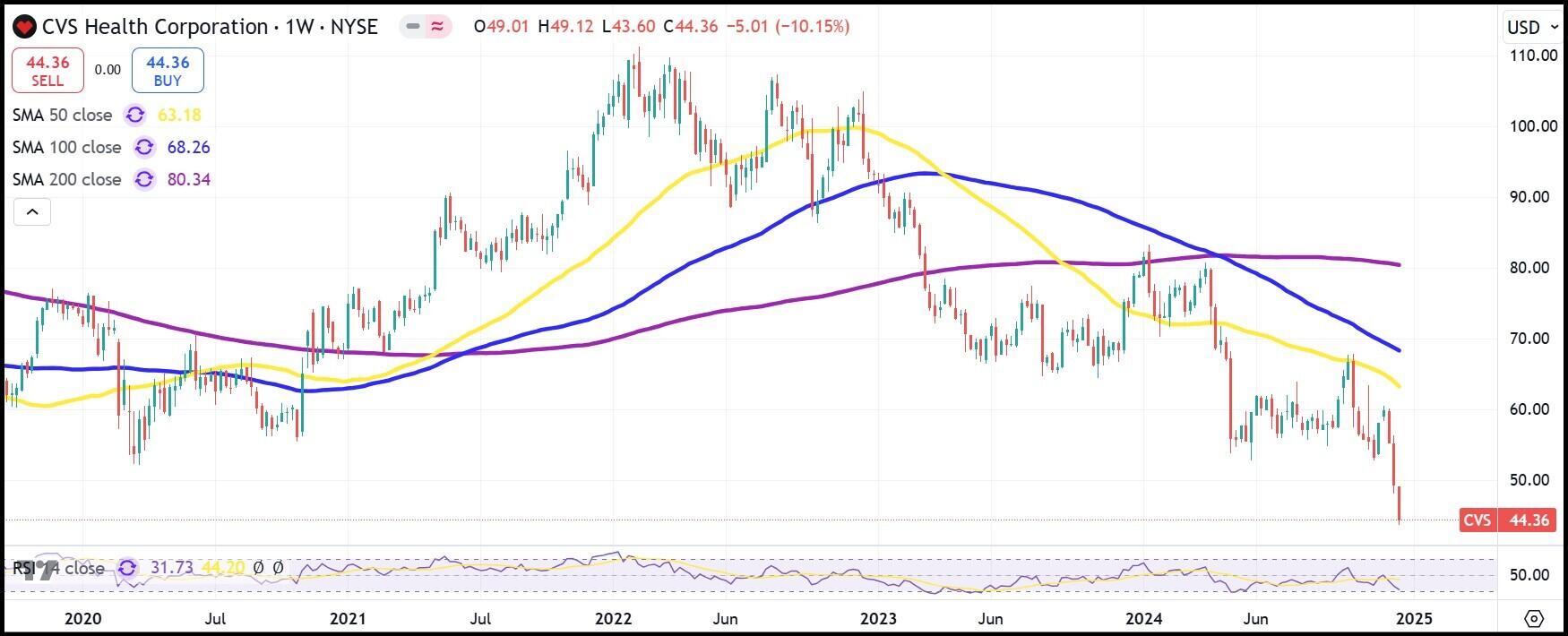
CVS Health (CVS) stock is one of the worst performers on this list, and that is exactly why I expect its fortunes will change in 2025. CVS stock fell more than 43% YTD in 2024, but the company is highly profitable and likely to revert to the mean this year.
The chain of pharmacies now owns Aetna, one of the nation’s largest health insurers. CVS Health trades for just eight times its net income, an absurdly low valuation. The sector median for health insurers is 20.
Deutsche Bank places a $66 price target on the shares that now trade for $44, and others on Wall Street see an $80 price tag in its future.
Deutsche Bank analysts wrote that CVS’ “earnings recovery is both achievable and will outpace Street expectations.”
Two separate issues have joined hands to pummel CVS’ share price of late. First, the murder of the UnitedHealthcare CEO in Midtown Manhattan on December 4 has scared the entire health insurance industry due to its general unpopularity with the public.
Second, Donald Trump has mentioned separating pharmacy benefits managers (PBM) from health insurers. Deutsche Bank was adamant that this would inflict pain on CVS’ business model, but it seems quite unlikely to happen. First, shaking up healthcare is not a Republican Party priority. Second, the first Trump administration was wholly incapable of legislating complex issues and instead preferred tax cuts and glad-handing. We expect more of the same.
Merck: Acquisitions, more healthcare spending should provide support
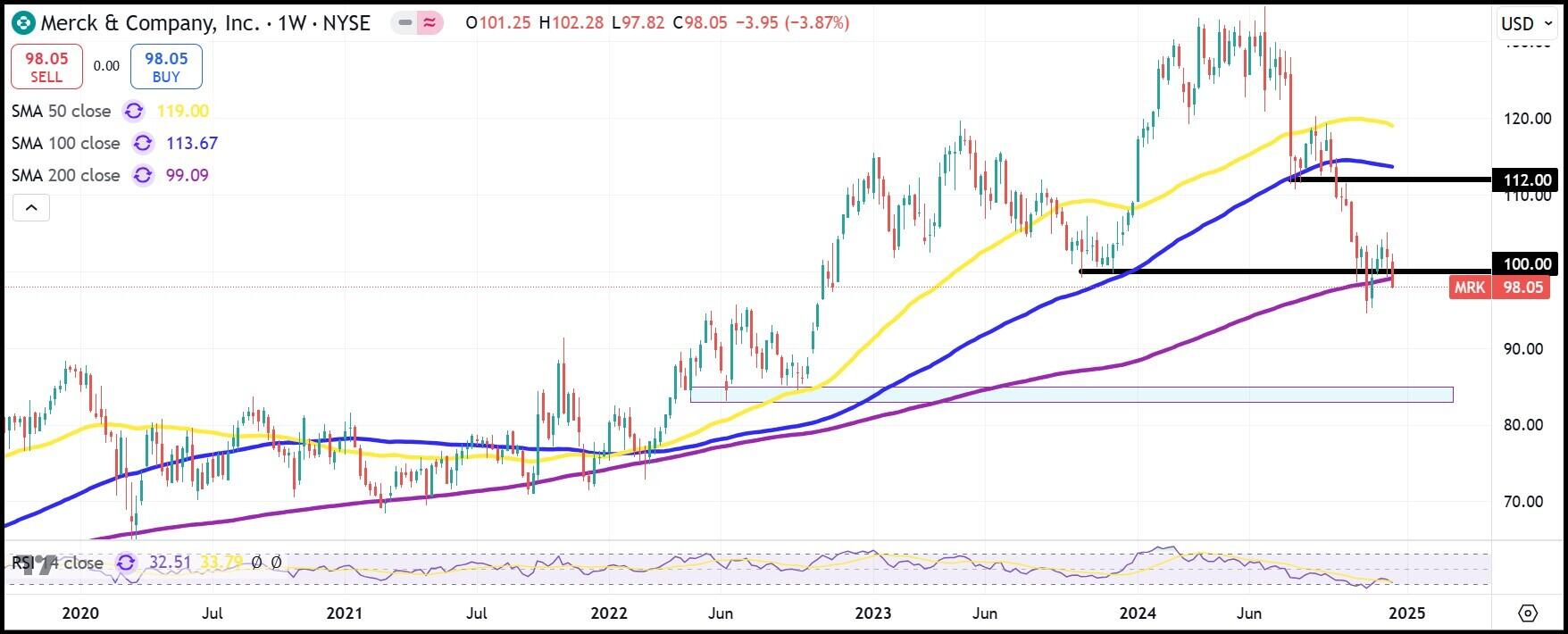
Merck (MRK) is another healthcare stock, this time a pharmaceutical name, that should benefit in 2025. Shares of the New Jersey-based company have fallen from the $130s to below $100 late this year, but the headwinds look overblown.
Many pharma stocks are seeing investors turn toward the exits after Trump named Robert F. Kennedy, Jr. as the head of his Health & Human Services Department. RFK Jr, as he is known, is a staunch opponent of vaccines.
However, at a recent event with pharma executives at Trump’s club in Florida, many execs went away feeling like they could work with the man. Kennedy told them that he simply wants to carry out further vaccine testing and claimed he won’t subject companies to needless oversight.
Additionally, Merck looks like a firm ready to start acquiring smaller biotechs with drugs under evaluation. Other competitors like Pfizer (PFE) and Bristol Myers Squibb (BMY) have already gone on this buyout route earlier in the cycle and have too much debt to compete.
Brandishing a better balance sheet, it’s now Merck’s turn to acquire the competition. With Trump at the helm, mergers are expected to go through without a hitch. What’s more, the rumor is that Merck might be interested in purchasing Moderna (MRNA), the pandemic darling.
US healthcare spending is expected to rise 7.5% in 2025, according to the Centers for Medicare & Medicaid Services. And that same government agency is expected to be less stringent with regulations under the new administration, which could pave the way for more opportunities in the pharma space.
RingCentral: Clearly undervalued
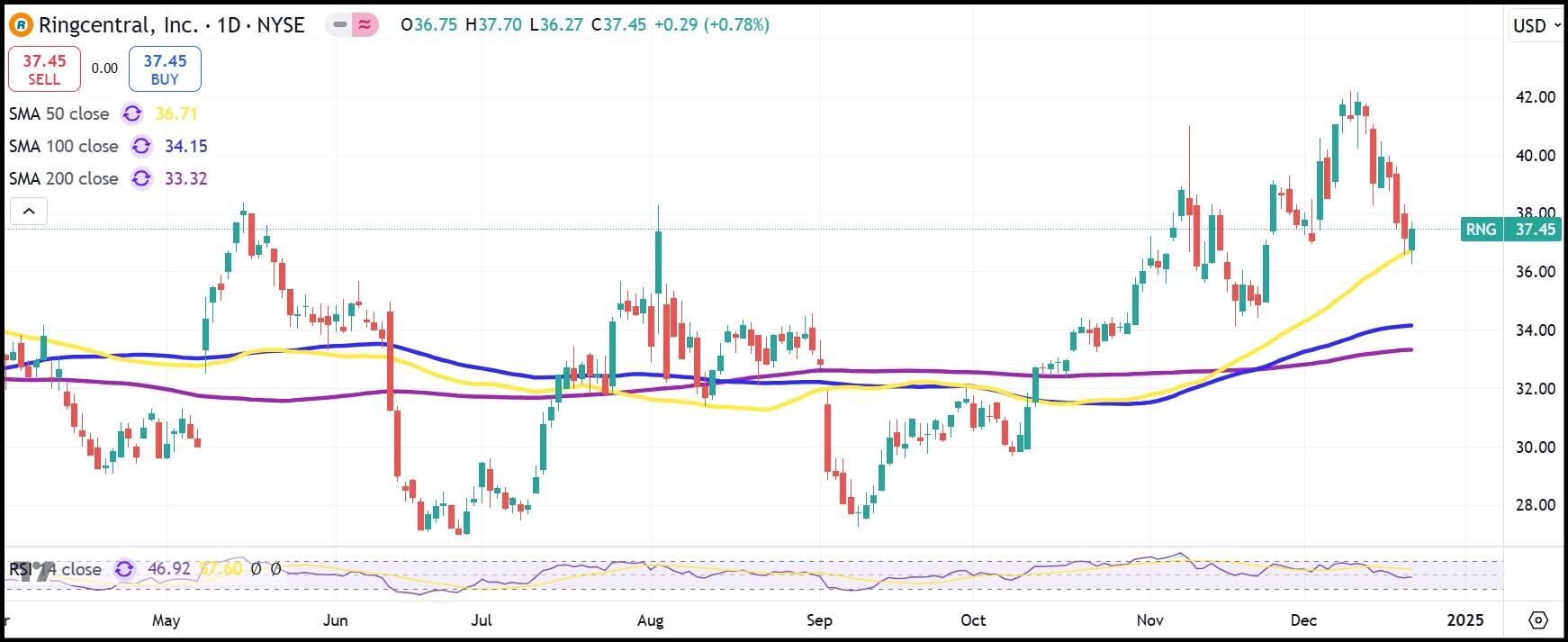
RingCentral (RNG), a company that provides call center software-as-a-service, is expected to see adjusted earnings per share (EPS) rise nearly 15% in 2025. That healthy pace comes even as the firm trades at just 10 times forward earnings. This is all while its competitors trade at an average of 25 times net income.
Simply put, RingCentral is an undervalued stock with a lot going for it. The margins are improving. Revenue is rising incrementally. And now, the company is releasing new products that could transform its business.
The first of these arrived on Halloween, so it hasn’t even been available for two months yet. The product is an AI assistant that listens to customer calls and automatically creates notes for the call center works. These include possible texts to send to customers on messaging apps.
The product “summarizes meetings with crisp action items, reducing employees’ daily mundane work to free up their time for more critical, strategic work.”
Next, in October, the company secured the first PAN-India license to deliver the nation’s first fully-complaint Unified Communications as a Service platform (UCaaS).
“Securing the PAN-India license marks the beginning of an exciting new chapter for RingCentral in India as we continue to push the boundaries of global collaboration and customer experience,” the company said in a statement.
